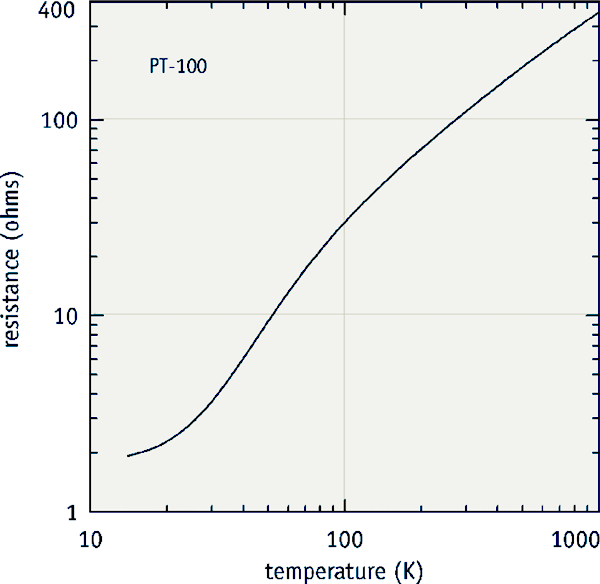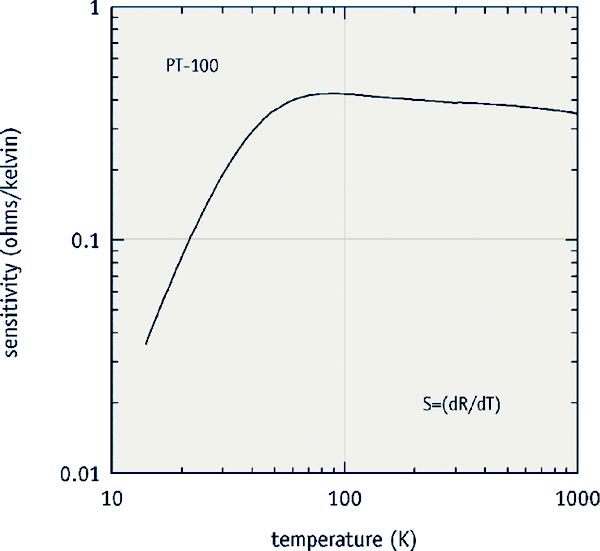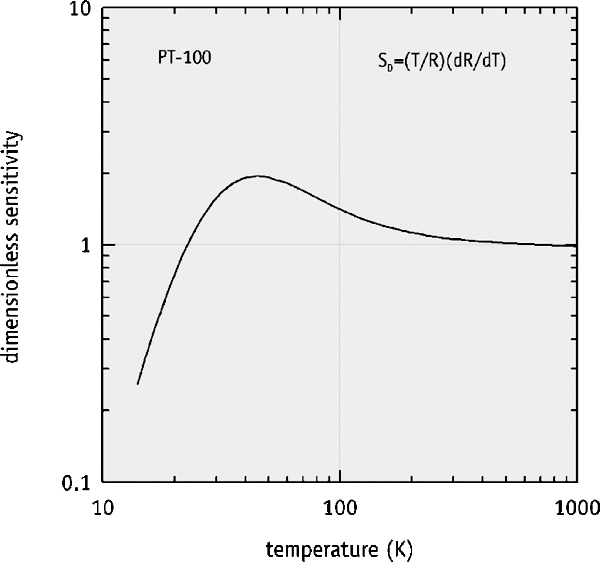Platinum sensor applications
PT-100 platinum resistance thermometers (PRTs) serve an important role in both cryogenic research and industrial cryogenics applications.
Research
Many cryogenic research platforms also include high-temperature capabilities, extending hundreds of degrees above room temperature. These platforms need temperature sensors that can both measure and survive these extreme temperatures. With a useful temperature
range of 14 to 873 K, platinum sensors are invaluable for this application.
Note: Platinum sensors lose sensitivity below 14 K. For temperatures below this, please see the sensor selection guide, as there are sensor options for lower temperatures, though there are none that can also exceed a 500 K maximum temperature.
Production and transport of liquid cryogens
The production and transport of many liquid cryogens (liquid nitrogen in particular) often see platinum sensors as the sensor of choice for temperature monitoring. Their bolt-down package option and interchangeability
options allow multiple sensors to be used with a single temperature curve, making them simpler to implement and maintain.
Typical platinum resistance

Typical platinum sensitivity

Typical platinum dimensionless sensitivity

Temperature curve options
In addition to the natural temperature accuracies of the 100 Ω Class B platinum sensors, Lake Shore offers several calibration and characterization options to suit different applications.

Uniquely characterized options
- Temperature vs. resistance curve is uniquely tailored for each sensor
- Not possible to use the same curve accurately with other sensors
- Achieved by measuring each sensor against known temperature standards at numerous temperature points
- Generally results in the most accurate measurement solution
Interchangeable options
- Sensors that are able to use a single temperature vs resistance curve that is not unique to any one sensor
- Each sensor is unique but will fall within a specified offset from the reference curve
- Generally less accurate than individually characterized sensors, but simpler to implement and maintain
Calibrated
| Sample accuracies |
| Temperature | Accuracy |
| 30 K | ±10 mK |
| 77 K | ±12 mK |
| 300 K | ±23 mK |
Characterized in a Lake Shore metrology cryostat from 14 K to one of several maximum temperatures. The most accurate solution available, but requires more time and effort, attracting a higher price than other options.
Will be the required sensor choice when the most reliable temperature measurements are of critical importance.
SoftCal™
| Sample accuracies |
| Temperature | Accuracy |
| 30 K | Not specified |
| 77 K | ±250 mK |
| 300 K | ±250 mK |
Each sensor is measured at several temperature points to create a unique curve adapted from the typical 100 Ω platinum sensor.
Useful in situations where a smaller number of sensors are required with only moderate accuracy is needed, and the sensors will primarily measure at or above LN2 temperatures
Matched
| Sample accuracies |
| Temperature | Accuracy |
| 30 K | Not specified |
| 77 K | ±125 mK |
| 300 K | ±500 mK |
A group of sensors (now up to 50) that are measured and selected to ensure they all fall within 0.1 K of a single reference sensor in that group at 77.35 K (LN2). This results in a group of sensors with a single curve
that is significantly more accurate than standard Class B platinum sensors.
This approach makes them ideal for applications such as liquid nitrogen transport lines in large cryogenic facilities, where the temperature sensors spend the majority of their time measuring the presence of liquid nitrogen.
More about matched sensors...
Uncalibrated
| Sample accuracies |
| Temperature | Accuracy |
| 30 K | Not specified |
| 77 K | ±1200 mK |
| 300 K | ±500 mK |
The default accuracy for 100 Ω Class B platinum sensors.
Most useful for temperatures that are relatively close to room temperature as these sensors become much less accurate at cryogenic temperatures or for situations where absolute accuracy is less important than identifying a change in temperature.
In what cryogenic applications are platinum sensors used?
Platinum resistance thermometer (PRT) sensors are highly useful in various applications due to their low price and usefulness in higher temperature systems. With operating ranges from liquid nitrogen temperatures (77.35 K) to many hundreds of degrees Celsius, they offer good sensitivity over the entire range. Lake Shore's 100 Ω PRTs adhere to the ISO standard temperature curve but have also been characterized for viable operation down to 14 K, making them the lowest temperature PRTs available. Above 70 K, PRTs offer high repeatability and nearly constant sensitivity (dR/dT). Because of their high reproducibility, they are used in many precision thermometry applications.